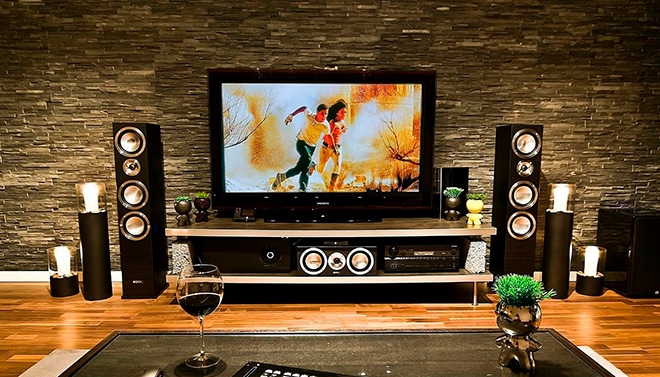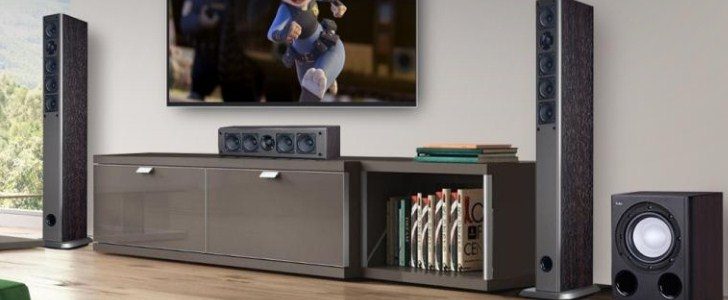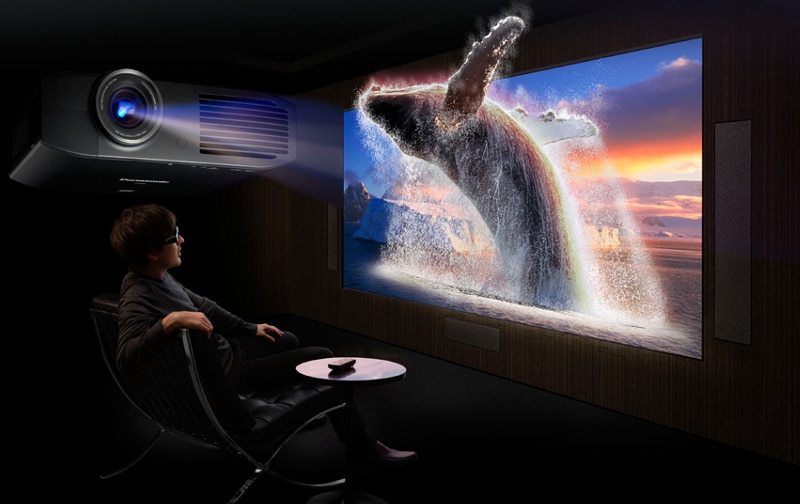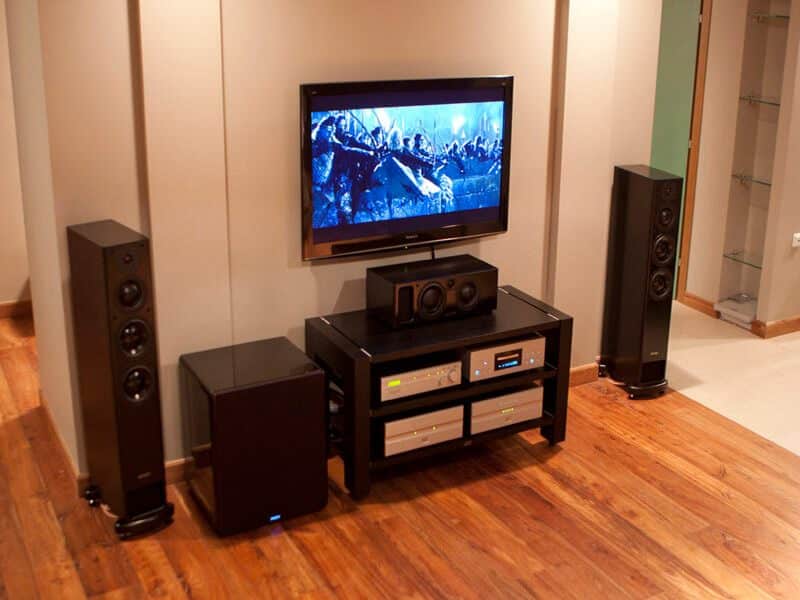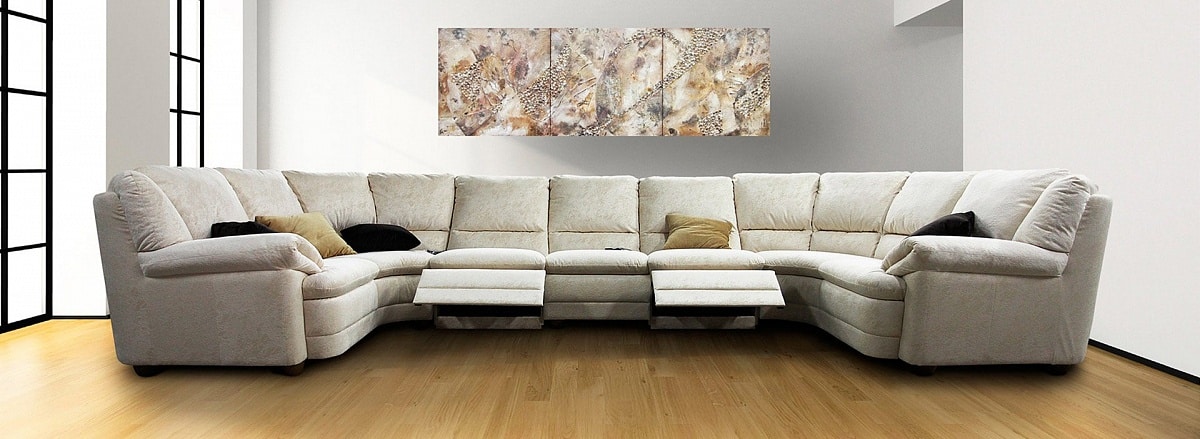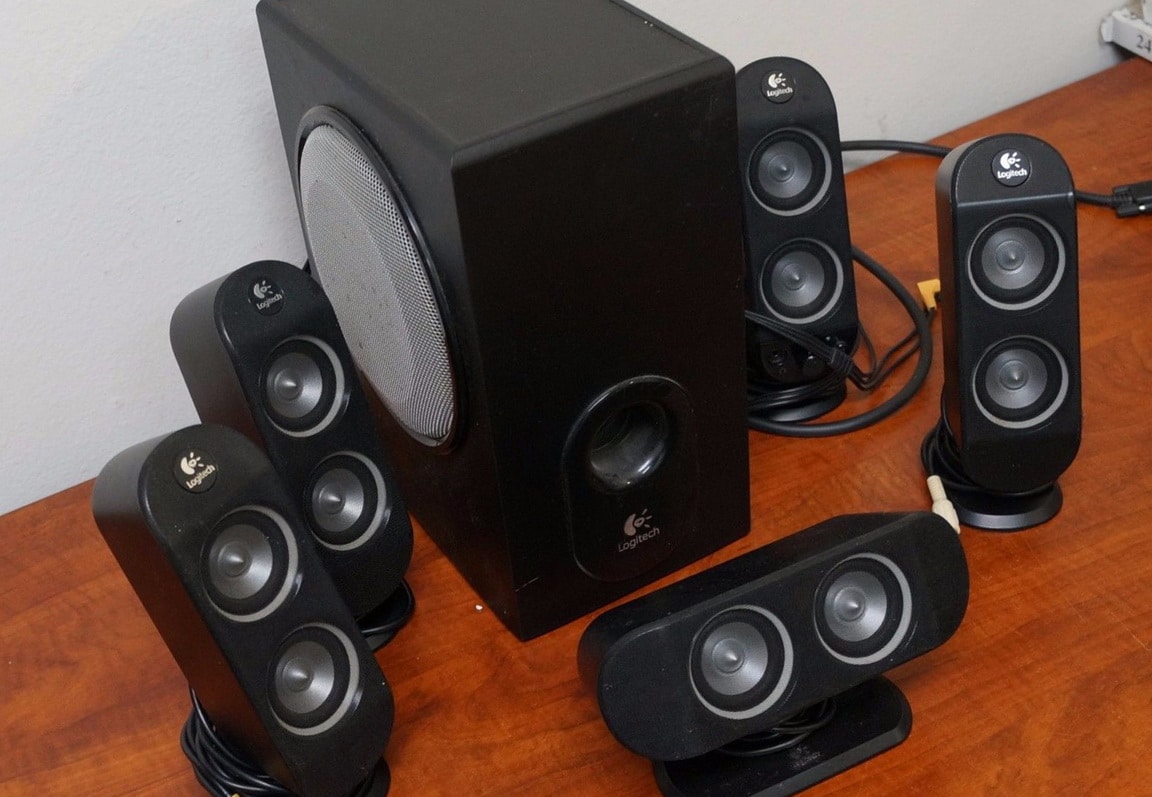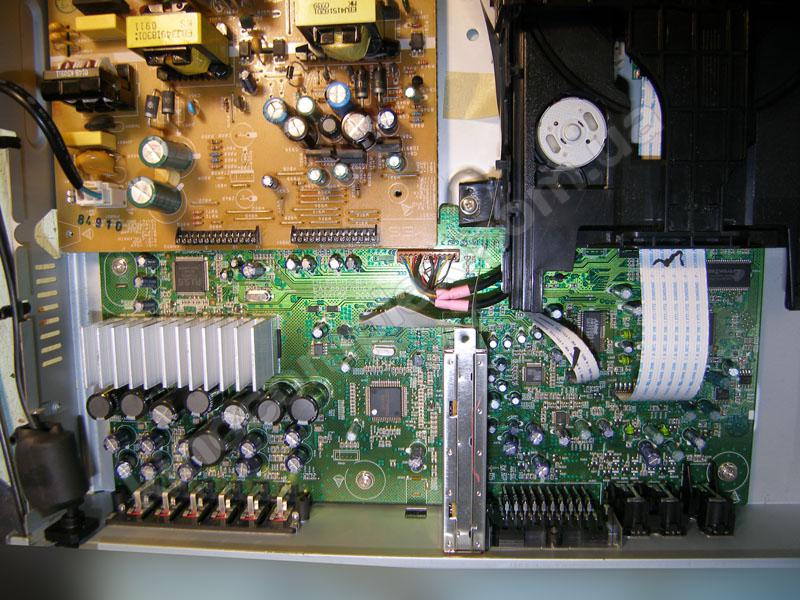Home theater includes a whole complex of equipment, which consists of an acoustic system, a multichannel amplifier, a
receiver and a video / audio signal source. Usually the kit does not include a playback device, so the TV or
projector must be purchased separately. Particular attention should be paid to the speaker system, because it is the sound format that can give the desired depth and liveliness to the sound.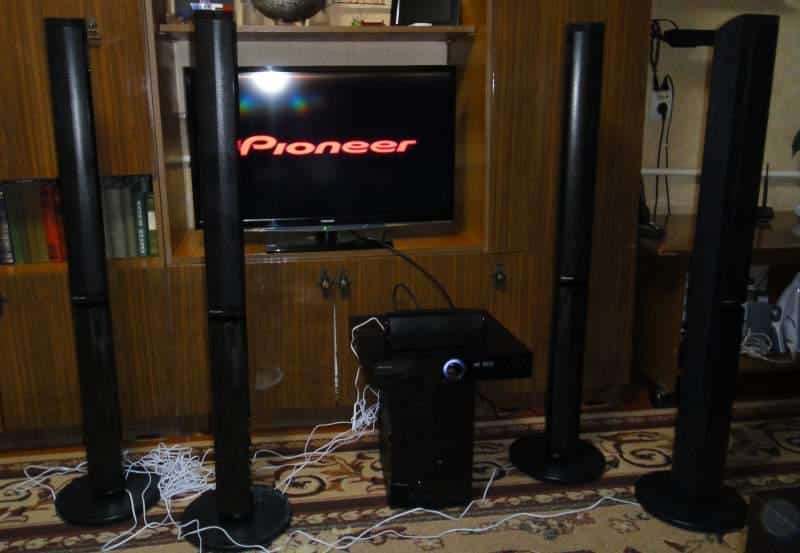
Acoustic system – home theaters 2.1, 5.1, 7.1
The sound format of acoustic systems is divided into three main types, namely: “2.1”, “5.1”, “7.1”. The first number in the sound system means the number of speakers, and the second number of
subwoofers . A standard home theater speaker system consists of 5 speakers and 1 subwoofer, however some manufacturers allow expansion of the sound system by purchasing more devices.
Home theater 2.1
As mentioned earlier, this system is equipped with two speakers and one subwoofer. Unlike standard TV sound, the latter is capable of deep bass, and the speakers on the sides give the sound a stereo effect.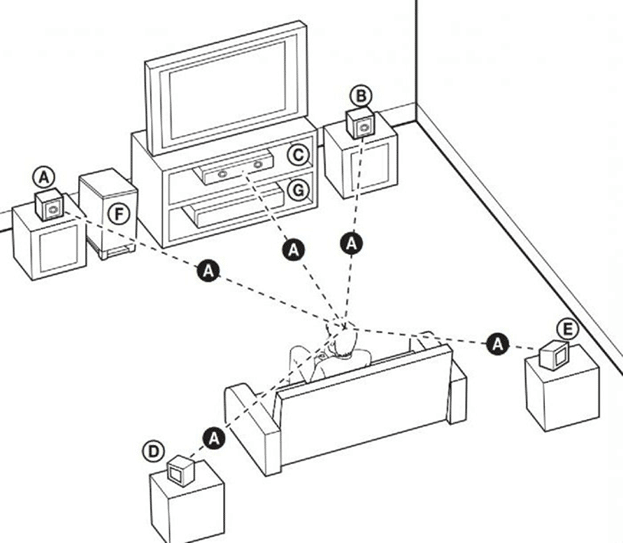 2.1 home theater system [/ caption] Such a speaker system is considered quite simple, since it has no surrounding playback devices, but the subwoofer undoubtedly makes the sound more spacious. But it cannot be considered a full-fledged volumetric system.
2.1 home theater system [/ caption] Such a speaker system is considered quite simple, since it has no surrounding playback devices, but the subwoofer undoubtedly makes the sound more spacious. But it cannot be considered a full-fledged volumetric system.
System 5.1
A 5.1 home theater system is a complete speaker system that delivers surround sound and the ultimate movie experience. Most home theater products are oriented towards this format, as described in their description. 5.1 system [/ caption] This format consists of six channels, five speakers responsible for high and middle frequencies, and one subwoofer, which is responsible for reproducing bass frequencies. Three speakers are located in the front, one center and two side speakers, and two more rear speakers are located in the back of the room to provide surround sound. More details can be found in the diagram below.
5.1 system [/ caption] This format consists of six channels, five speakers responsible for high and middle frequencies, and one subwoofer, which is responsible for reproducing bass frequencies. Three speakers are located in the front, one center and two side speakers, and two more rear speakers are located in the back of the room to provide surround sound. More details can be found in the diagram below. Despite the number of variations in the placement of 5.1 speaker systems, this configuration is considered the most successful, since the viewer finds himself in the center, towards which all sound devices are directed. However, if the room is large enough, then it makes sense to experiment with the location to achieve the most acceptable result. It should be noted that this audio format can be used for playback from most sources. For example, modern video players and digital television support surround sound, even desktop sound cards are mostly compatible with it. 5.1 home theater setup: https://youtu.be/66I0IvlsZaE
Despite the number of variations in the placement of 5.1 speaker systems, this configuration is considered the most successful, since the viewer finds himself in the center, towards which all sound devices are directed. However, if the room is large enough, then it makes sense to experiment with the location to achieve the most acceptable result. It should be noted that this audio format can be used for playback from most sources. For example, modern video players and digital television support surround sound, even desktop sound cards are mostly compatible with it. 5.1 home theater setup: https://youtu.be/66I0IvlsZaE
Home theater system 7.1
This system differs from the 5.1 format by the presence of two additional speakers, which are located between the front and rear. This eight-channel option is less in demand than its predecessor, but such home theaters can be found commercially. The main advantage of this configuration is even more spacious sound, since the additional two speakers form a full circle. They are designed to create ambience and usually do not reproduce the main sound.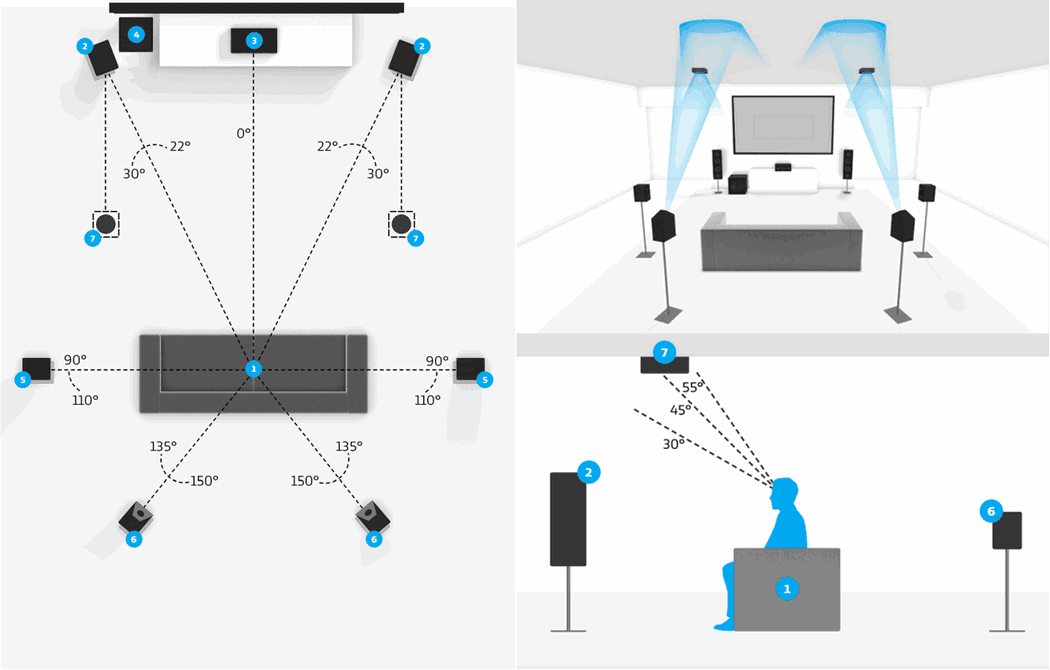 7.1 Home Cinema – Connection Diagram [/ caption] To get the best sound from this system, you need to move the rear playback devices closer together in relation to the diagram above. The final arrangement of the columns should resemble a rounded shape.
7.1 Home Cinema – Connection Diagram [/ caption] To get the best sound from this system, you need to move the rear playback devices closer together in relation to the diagram above. The final arrangement of the columns should resemble a rounded shape.
How to choose a home theater 5.1,7.1
Buying a home theater is primarily a desire to immerse yourself in the thick of events on the screen. To do this, you need to choose the right speaker system, which will not only be able to accompany the picture on the screen with sound effects, but also provide decent quality. General guidelines for choosing home theaters:
- Power is an important metric in a home theater system. Of course, it is unlikely that you will be able to listen to powerful acoustics at full volume in rooms, but the power will allow you to avoid sound distortion, therefore, in this case, the more powerful the better.
- The material from which the home theater is made affects not only the external component, but also the sound quality. The case must be strong enough, so wood, plastic or metal should be considered as a material.
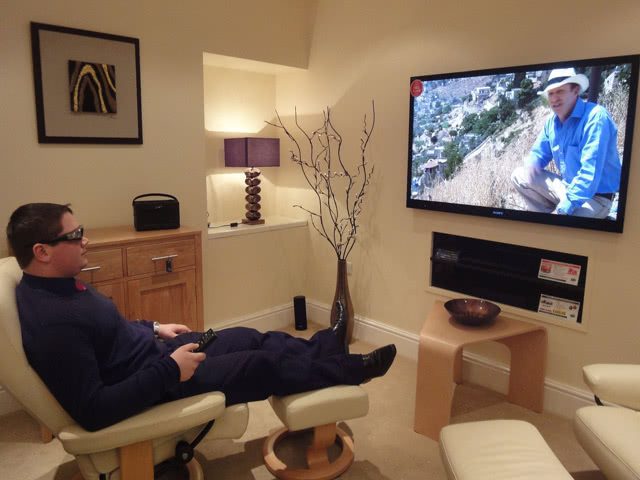
- Depending on the room , the speaker design should be considered correctly. They can be floor-standing, wall-mounted and mounted, but the floor-standing version can produce a deeper sound. And the hinged options can be used in systems where the speakers are also on top.
- Frequency range . The human ear perceives sounds in the 200-20000 Hz range, so you should choose a speaker system that is capable of reproducing sounds in this range.
- The sensitivity parameter is responsible for the volume of the speakers, which is equal to the amperage exiting the amplifier. Simply put, the higher the sensitivity, the louder the final sound.
- Arrangement of the speaker system . Some home theaters require non-standard placement of playback devices, this is due to the peculiarities of specific models. This factor should be taken into account, otherwise an unpleasant situation may arise, for example, there is not enough space in the room, therefore it will not be possible to fully unleash the potential of a home theater.
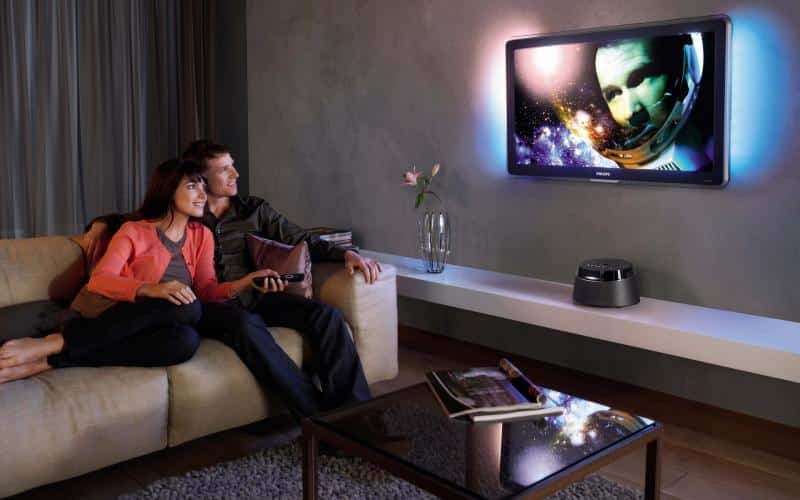 It is strongly discouraged to buy home theaters from unknown brands. Of course, the prices for such models look very attractive, but such pricing is formed by saving on some parts of the equipment, so it is better to buy products from time-tested brands, such as
It is strongly discouraged to buy home theaters from unknown brands. Of course, the prices for such models look very attractive, but such pricing is formed by saving on some parts of the equipment, so it is better to buy products from time-tested brands, such as
Samsung , Sven or
LG . What is 5.1, 7.1, DOLBY ATMOS, ARC, RCA, SPDIF, basic home theater audio terms: https://youtu.be/eBLJZW08l1g
Set of 2 speakers and 1 subwoofer
The main advantage of this kit is its compactness. Of course, this option cannot be considered a full-fledged surround sound, since the speakers are located only in the center, however, a powerful amplifier complete with a subwoofer can give a new experience from old movies and listening to music. This option fits perfectly into a small room, and at a price it is much cheaper. It is worth noting that in the future this option can be expanded by purchasing additional equipment, but on condition that the receiver allows you to connect additional speakers.
5 speakers and 1 subwoofer
A full-fledged speaker system, which, if properly placed and connected, can completely immerse the viewer in what is happening on the TV screen. Among the shortcomings, one can single out bulky dimensions and prices for good equipment. Of course, you can find a home theater system with a 5.1 sound format in moderate dimensions, but this option will seriously affect the sound quality, since the cabinet is an important part of the speakers. This system is suitable for spacious rooms where there is room for large speakers. However, the larger the room, the more powerful acoustics will be required, so you should not overdo it with the choice of the room.
7 speakers and 1 subwoofer
A variant of the advanced version of the predecessor speaker system, guarantees an even more complete immersion due to additional rear speakers, but requires more space. The system is only suitable for large rooms, since a significant distance between the speakers is required to achieve maximum effect. https://cxcvb.com/texnika/domashnij-kinoteatr/kakoj-vybrat.html Layout of the acoustic system 7.1.
How to connect a speaker system
Since there are no special differences in the methods of connecting speaker systems of different sound formats, an example based on 5.1 acoustics is given here. The first step is to properly position the speaker system. While everything is clear with the central ones, they usually differ in shape, then with the lateral and rear ones, everything is a little more complicated. Manufacturers mark them with literal expressions, from them you can determine which should be on the left and which on the right.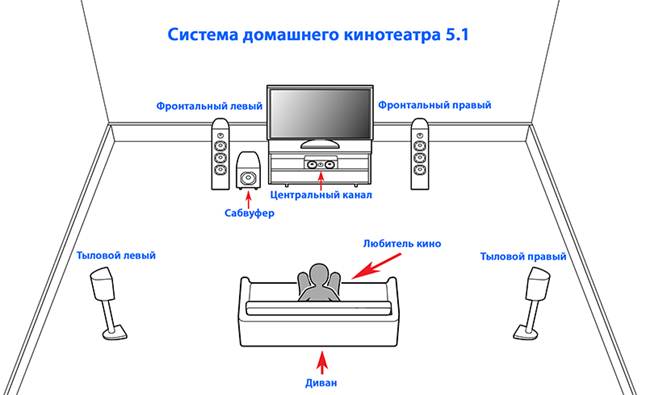 Placing the user and home theater elements in the room [/ caption] You can immediately connect the speakers to the receiver. To do this, use tulip-type wires, the red and white wires are responsible for the sound. They must be connected to the corresponding ports on the receiver. The speakers and connectors are marked with the same names, so it is enough to connect the connector on the receiver to the connector on the speaker. This procedure must be repeated with all speakers and subwoofer.
Placing the user and home theater elements in the room [/ caption] You can immediately connect the speakers to the receiver. To do this, use tulip-type wires, the red and white wires are responsible for the sound. They must be connected to the corresponding ports on the receiver. The speakers and connectors are marked with the same names, so it is enough to connect the connector on the receiver to the connector on the speaker. This procedure must be repeated with all speakers and subwoofer. It should be noted that the “tulip” cable can be replaced with alternatives of the “mini-jack” type and the like. If so, then it is enough to connect the devices with one wire to each other.
It should be noted that the “tulip” cable can be replaced with alternatives of the “mini-jack” type and the like. If so, then it is enough to connect the devices with one wire to each other. Connection diagram [/ caption] Next, you should connect the desired video source to the receiver, for example, a television receiver or any video player. It is preferable to do this with an HDMI cable, since it is capable of transmitting audio and video signals in good quality. It should be connected to the “HDMI IN” jack.
Connection diagram [/ caption] Next, you should connect the desired video source to the receiver, for example, a television receiver or any video player. It is preferable to do this with an HDMI cable, since it is capable of transmitting audio and video signals in good quality. It should be connected to the “HDMI IN” jack.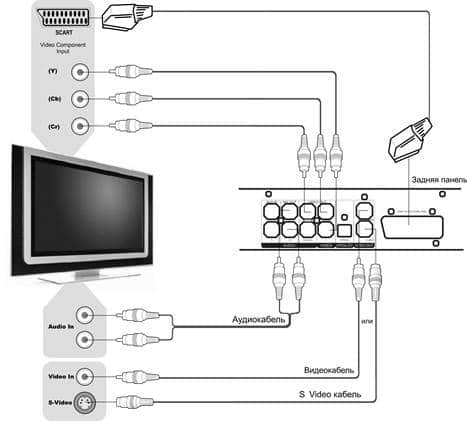 An example of connecting a home theater – instructions from the manufacturer [/ caption] It remains to connect the receiver to an output device, for example, to a TV. This can be done with the same “HDMI” cable, only this time you need to connect to the “HDMI OUT” or “VIDEO OUT” port, and then insert the other end of the cable into the “HDMI IN” connector on the TV.
An example of connecting a home theater – instructions from the manufacturer [/ caption] It remains to connect the receiver to an output device, for example, to a TV. This can be done with the same “HDMI” cable, only this time you need to connect to the “HDMI OUT” or “VIDEO OUT” port, and then insert the other end of the cable into the “HDMI IN” connector on the TV.
